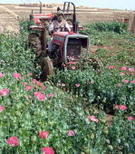 In the midst of all the doom and gloom coming from Afghanistan, the UN has published a report saying that there had been a 22 percent decrease in poppy cultivation in the country and a 33 percent reduction in Helmand alone. The number of “poppy free” provinces has also increased from 18 to 20. The UN called this “undeniable progress” and a “dramatic turn. Desperate for good news, the FCO welcomed “this progress” and credited Helmand Governor Gulab Mangal for giving “people a real alternative to drugs and the Taliban.”
In the midst of all the doom and gloom coming from Afghanistan, the UN has published a report saying that there had been a 22 percent decrease in poppy cultivation in the country and a 33 percent reduction in Helmand alone. The number of “poppy free” provinces has also increased from 18 to 20. The UN called this “undeniable progress” and a “dramatic turn. Desperate for good news, the FCO welcomed “this progress” and credited Helmand Governor Gulab Mangal for giving “people a real alternative to drugs and the Taliban.”
No doubt Governor Mangal did his best, alongside Gul Agha Sherzai of Nangarhar province, which in the past used to be one of the country’s main opium hubs. But, according to the UN, the real reason for the drop in cultivation has been due to overproduction and a corresponding drop in worldwide opium prices relative to other crops like wheat.
There are also plenty of reasons to worry about future trends, which the UN report concedes albeit obliquely. Though the area under cultivation has dropped down to 123,000 hectares from a peak of 193,000 ha in 2007, it is still a long way from the 7-8000 hectares used for opium cultivation in 2001. The UN report also acknowledges that the farmers are getting better at cultivating the illegal crop. While land use is down 22 percent, production is down only ten percent, because farmers now produce 15 percent more opium resin from poppies. This year, Afghan poppies yielded 56 kg of opium per hectare, which is a 15 percent increase over 2008 and five times more than what opium farmers yield in the Golden Triangle of South-east Asia.
And, while the UN and the FCO like to talk about of “poppy free” provinces, they are nothing of the sort. Traders in these provinces have moved up the value chain – in other words, from cultivation to processing – or into cannabis.
In the provinces where cultivation still takes place, the basic incentives for farmers – rich, poor or indebted – has not yet changed. Growing opium remains an attractive move for many farmers because of the crops’ price, durability, and the economic system set up by the narcotics networks, which bring seeds to the farm gate, provide agricultural advice and pick up the harvested crop – thus saving the farmer the dangerous trip to the market to sell the harvest.
Finally, there is no sign that the Afghan government, despite millions of pounds spent on police assistance, is willing or able to prosecute high-level drug lords. As a result, the war-torn country now has its very own politically-connected drug cartels, who live in a “marriage of convenience” with anti-government insurgents who, in turn, have gone from merely taxing opium-growing in areas they control (which they have done for years), but are now working with criminal gangs and corrupt officials to produce, process, stock, and export opium.
So, it may not be time to celebrate this year’s drop in opium cultivation just yet. Afghan drugs still represents the country’s biggest economic activity, and one which funds criminals, insurgents, and terrorists in Afghanistan and abroad.






Comments